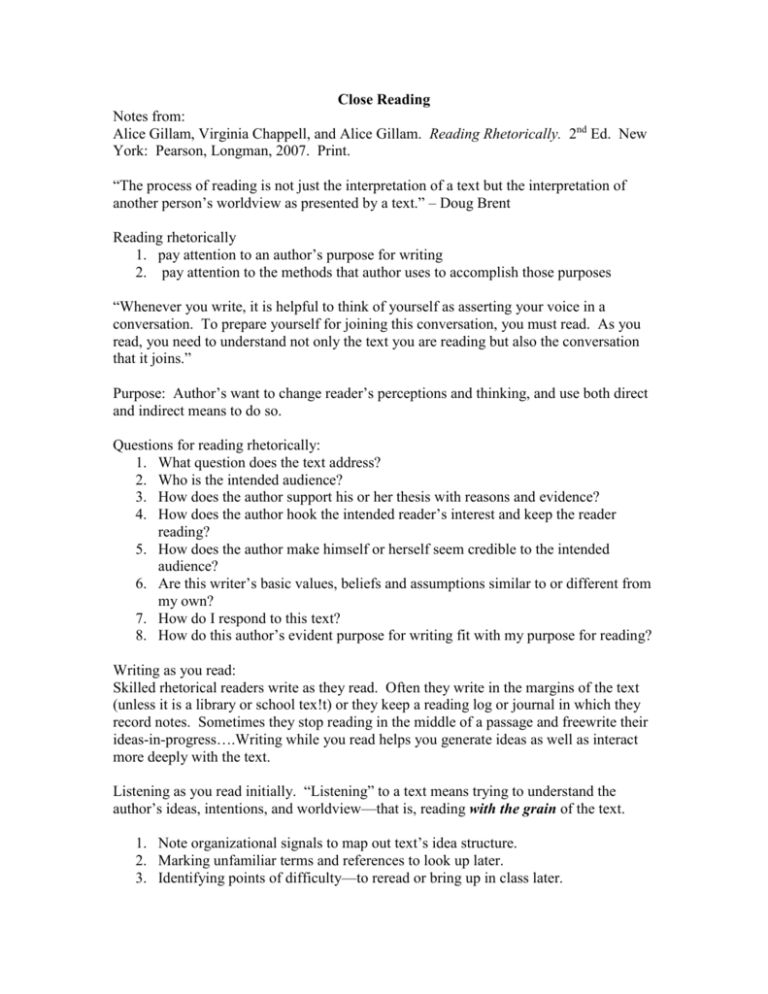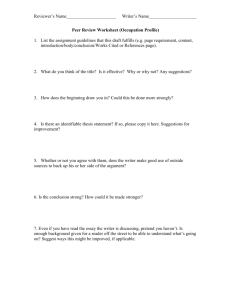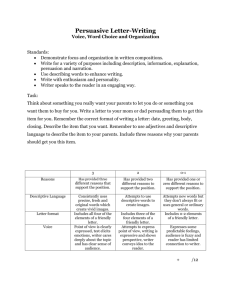
Close Reading
Notes from:
Alice Gillam, Virginia Chappell, and Alice Gillam. Reading Rhetorically. 2nd Ed. New
York: Pearson, Longman, 2007. Print.
“The process of reading is not just the interpretation of a text but the interpretation of
another person’s worldview as presented by a text.” – Doug Brent
Reading rhetorically
1. pay attention to an author’s purpose for writing
2. pay attention to the methods that author uses to accomplish those purposes
“Whenever you write, it is helpful to think of yourself as asserting your voice in a
conversation. To prepare yourself for joining this conversation, you must read. As you
read, you need to understand not only the text you are reading but also the conversation
that it joins.”
Purpose: Author’s want to change reader’s perceptions and thinking, and use both direct
and indirect means to do so.
Questions for reading rhetorically:
1. What question does the text address?
2. Who is the intended audience?
3. How does the author support his or her thesis with reasons and evidence?
4. How does the author hook the intended reader’s interest and keep the reader
reading?
5. How does the author make himself or herself seem credible to the intended
audience?
6. Are this writer’s basic values, beliefs and assumptions similar to or different from
my own?
7. How do I respond to this text?
8. How do this author’s evident purpose for writing fit with my purpose for reading?
Writing as you read:
Skilled rhetorical readers write as they read. Often they write in the margins of the text
(unless it is a library or school tex!t) or they keep a reading log or journal in which they
record notes. Sometimes they stop reading in the middle of a passage and freewrite their
ideas-in-progress….Writing while you read helps you generate ideas as well as interact
more deeply with the text.
Listening as you read initially. “Listening” to a text means trying to understand the
author’s ideas, intentions, and worldview—that is, reading with the grain of the text.
1. Note organizational signals to map out text’s idea structure.
2. Marking unfamiliar terms and references to look up later.
3. Identifying points of difficulty—to reread or bring up in class later.
4. Connecting any visual elements to the text.
5. Annotating a text provides a record to use later for rereading, writing, or studying
for test.
Questioning a text as you read. Reading against the grain. Learning to question a
text is central to your academic success in college. It doesn’t necessarily mean just
fault-finding, and it certainly doesn’t mean dismissing an author’s ideas wholesale.
Rather, you carefully examine a text’s claims, evidence, and subtle forms of
persuasion to make your own sound judgment and thoughtful response.
Strategies for questioning a text:
1. Examining a writer’s credibility: Do I find this author believable and
trustworthy? Why or why not?
2. Examining a writer’s appeals to reason: Do the writer’s reasons and evidence
convince me to take his or her position? Do I share his/her assumptions?
3. Examining a writer’s strategies for engaging reader’s interests and emotions:
How does a writer hook and keep your interest? How does he/she make you care
about the subject?
4. Examining a writer’s language: Pay careful attention to language and style. Ask
why a writer made certain choices (e.g. comparing something to cancer which
invokes fear in the reader) rather than choosing other words to express the same
idea.
5. Examining a text’s ideology or worldview. Look for signals that reveal the
ideology informing a text. One way to do so is to look for patterns of opposites or
contrasts in a text (sometimes called binaries) and see which of the opposing
terms the writer values more. For example: male versus female; civilized versus
primitive; Caucasians versus people of color. When binaries occur in a text, one
is generally valued above the other. Seeing the pattern of these values shows you
the writer’s ideology or worldview.








